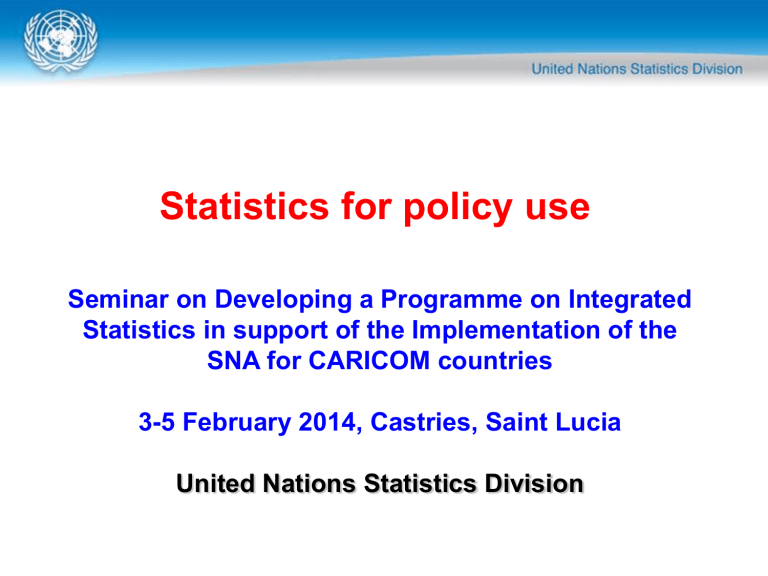Statistics for policy use

Statistics for policy use
Seminar on Developing a Programme on Integrated
Statistics in support of the Implementation of the
SNA for CARICOM countries
3-5 February 2014, Castries, Saint Lucia
United Nations Statistics Division
Outline of Presentation
Introduction
System of National Accounts
Economic indicators approach to macroeconomic analysis
2
Macroeconomic framework
To establish an enabling macroeconomic policy framework for equitable and sustainable development
Requires a clear understanding of the underlying factors that drive national income growth, including:
• growth in capital accumulation,
• changes in employment rate,
• labour and capital productivity,
• changes in the terms of trade and
• linkages between macroeconomic policies and industrial and sectoral policies.
3
The need to be informed
This gives rise to the need, not only to monitor progress but also to evaluate whether or not goals are being achieved.
To obtain this overview of the economic processes data need to be organised in a framework that integrates and reconciles the data.
4
The need to be informed
Requires data of sufficient scope, detail and timeliness to analyse:
• the external and internal economic and financial vulnerabilities,
• the interconnectedness of the global production and the global financial system;
• the causes of changes in economic growth and employment patterns; and
• to inform about the trade-offs between fiscal, monetary and debt reform and initiatives to increase growth, employment and equity.
5
System of National Accounts
SNA describes a coherent, consistent and integrated set of macroeconomic accounts that provides an overview of economic processes, recording how:
• production is distributed among consumers, businesses, government and foreign nations.
• income originating in production, modified by taxes and transfers, flows to these groups and
• they allocate these flows to consumption, saving and investment.
• The latest version of the SNA is the 2008 SNA http://unstats.un.org/unsd/nationalaccount/docs/SNA2
008.pdf
6
System of National Accounts
The SNA embodies basic distinctions as required by economic theory such as:
• production (supply) and use (demand) with prices
• factors of production such as labour, capital, technology
• transactions such as income, consumption, investment, exports, imports, transfers, financial assets and liabilities
• balance sheets with positions of assets and liabilities
• (institutional) sectors such as household sector, corporate sector, monetary sector, government sector, external sector
7
System of National Accounts
The national accounts support macroeconomic and sectoral policies including those related to
• employment,
• inflation,
• international trade, and finance
• growth and productivity of the economy
Consequently, the national accounts provide an overarching framework for macroeconomic statistics to facilitate economic analysis and policy formulation
8
SNA and Intermediate Accounts for Policy Analysis
ECONOMIC
THEORY
SYSTEM OF
NATIONAL
ACCOUNTS
ECONOMIC
ISSUES
Concepts and definitions
Indicators
Accounts
Basic data and statistics
Policies and perspectives
9
Economic indicators approach to macroeconomic analysis
A set of national accounts data is generally too large and conceptually too complex for users to handle in analysis.
Users require that the data set be summarized into a smaller set of indicators that could be used to assess economic conditions and development of a country.
Indicator analysis – generally indicator ratios are used.
The reason for using ratios between data rather than the data themselves is that data generally provide little information, unless they are related to other data.
10
Economic indicators approach to macroeconomic analysis
Example:
GDP figure becomes only meaningful
if its growth over time is analysed, a per capita figure is derived that makes it possible to compare the data between countries, or a
percentage breakdown by expenditures or activities is presented.
Similarly, data about the level of imports are not very informative unless
they are related to exports or
to domestic output, or
a breakdown by products is shown .
11
Economic indicators approach to macroeconomic analysis
Aggregates, such as GDP and GDP per capita, are widely used as summary indicators of economic activity and welfare.
While useful in their own right, they are not the most suitable measures of people’s material conditions.
The GDP as the single most important measure of economic performance and social progress does not reflect ordinary people’s perceptions of their economic conditions.
The GDP also don’t reflect the link between environmental sustainability and economy performance.
12
Economic indicators approach to macroeconomic analysis
National accounts provides valuable information on household material conditions at the macro level, such as:
• measures of household disposable income;
• social transfers in kind;
• consumption expenditure;
• investment; and assets and liabilities.
13
Economic indicators approach to macroeconomic analysis
By combining these macro level aggregates with micro sources (surveys, administrative records, and censuses), it would be possible to derive measures across household groups of their
• distribution of income,
• consumption and
• wealth
14
Economic indicators approach to macroeconomic analysis
Indicator ratios are roughly grouped by types that describe economic conditions and development of the economy and/or policies aimed at influencing developments
First - describe the total economy and its relations with the
ROW
• aggregates per capita and per worker, prices and BOP
Second - describing production by industries and sectors
•
Production, behaviour and participation of corporations in the economy
Third - elements of fiscal policies and the impact of those on other sectors
• behaviour and participation of Government in the economy, taxes
15
Economic indicators approach to macroeconomic analysis
By linking the indicators to macro-economic framework, it would be possible to identify not only the issues but also the underlying variables that could measure the impact of policies addressing the issues.
As a macro accounts framework is generally used to address policy issues within a country, the development of indicators based thereon
• would stimulate the use of those indicators by national
Governments in their assessment of national conditions and developments,
• in addition to the present use of indicators by international agencies.
16
Advantages of economic indicators approach
Simple and understandable economic constructs that summarize the development of the economy and the economic and financial vulnerabilities over time.
Economic indicators within a balanced system of national accounts are mutually consistent.
Economic indicators use the real and financial interconnectedness within sectors, between sectors and their counterparties in the rest of the world.
Economic indicator analysis improve the use of national accounts and its quality and reveal data gaps
17
Performance Indicators for Industrial Statistics
Performance indicators make it possible to evaluate performance of producer units and the industrial sector.
Objectives of industrial performance indicators
• As a policy-relevant statistic, provide a summary of the performance of a unit or the sector.
• Simplified means of summarizing and communicating complex information to decision makers.
• Help policy makers monitor and evaluate industrial activity and inform strategic decision making.
• Help businesses to assess business environment in which they operate
• Assist researchers and academicians for making
comparisons across countries and industries over time.
18
Types of Performance Indicators
3 broad types
• Growth rates
• Ratio indicators
• Share indicators
Most have comparative dimension or a reference point allowing for time series evaluation.
Used to measure overall performance of the industrial sector, so not desirable to sacrifice this goal for achieving detailed compilation on indicators of minor performance requiring much detailed data.
19
Performance Indicators: Growth Rates
Value added growth
• Expressed as (Y t
/Y t-1
)-1
• Y and t denote the value added and time period, respectively.
Growth of employment in the industrial sector
• Annual (monthly or quarterly) percentage change of persons employed.
• Can be compiled by economic activities, by gender, and by size class of establishments.
20
Performance Indicators: Ratio Indicators
Output per person employed
• Useful for tracing labor requirement per unit output
• Reflects the change of the input coefficient of labor by industry
Output per hour worked: total output/hours worked
Value added per person employed: popular method for estimating trends in labor productivity
Ratio of orders to shipment: useful for monitoring sub annual trends
• New orders received
• Unfilled orders at the end of inquiry period
21
Performance Indicators: Ratio Indicators (II)
Intensity of energy consumption by activity
• Quantity of energy consumed in terajoules per unit of value added
• Declining trends indicate improvements in energy efficiency
Water-use intensity by economic activity
• Volumes of water (in cubic meters) per unit of value added. Volume consists of the sum of a) quantity of water abstracted from the environment, plus b) the quantity of water purchased , minus c) quantity of water sold.
• Indicates extent of pressure of the economy on water resources
Ratio of environmental protection expenditure to value added
• Measures the efforts of an industry to protect the environment
22
Performance Indicators: Share Indicators
Share of industrial activity value added in total value added
• Depicts the structural composition of the economy
• Shows the contribution of individual economic activities to
GDP
Employment in industrial activity as a share of total employment
• Useful tool to assess segmentation and trends of the labor market
• Ratio of total number of persons employed in industrial activity to total number of person employed in the economy.
23
Links between statistics, macro accounts, indicators, projections and policies
Projections of future development
[c]
[b]
Policy analysis and formulations
[a]
[h]
Selection and compilation of indicators measuring past trends
[e]
[g]
Macro accounts design and compilation
[f]
Statistics and statistical development
[d]
24
Links between statistics, macro accounts, indicators, projections and policies
Indicators and macro accounts play a central role in statistical development and policy formulation.
Policy formulation could be based on the use of indicators measuring past and present trends [a]
May also take into account future developments that are based on alternative values of the indicators in the future
[b].
The use of indicators in projections is reflected in a direct link with the indicators measuring past trends [c].
25
Links between statistics, macro accounts, indicators, projections and policies
In order to define statistical development that would support policy formulation, links are needed to translate policy formulation
• into indicators [d].
• indicators into the design and compilation of macro accounts
[e] and
• macro accounts into statistical development [f].
The derivation of values of indicators are represented by the reverse links
• between statistics and the compilation of macro accounts
[g], and
• between the macro accounts data and the derivation of indicator values [h].
26
Scope of Macro-economic Analysis by Milestones and
Minimum Required Data Set (MRDS)
Milestone 1 .GDP by Industry and Expenditure in current and volumes
Growth analysis
Milestone 2.
GNI of Total Economy and Balance of Payments (current, capital and financial accounts) and GFS transaction accounts
Relations with the rest of the world (BoP) analysis
Milestone 3.
Production and generation of income accounts for institutional sectors and for GG income distribution accs (including IIP for BoP and GFS transactions and stock in assets and liabilities)
Productivity analysis and fiscal analysis
Milestone 4 . Production, generation, distribution, redistribution and use of income accounts and capital accounts for all institutional sectors (up to net lending)
Income distribution analysis
--------------- Minimum required macroeconomic data set, annual institutional sector accounts up to net lending and quarterly GDP and quarterly BoP
27
Scope of Macro-economic Analysis by Milestones and
Minimum Required Data Set (MRDS)
Milestone 5.
Production, income and use accounts, capital accounts and financial accounts for institutional sectors
Growth analysis, BOP analysis, productivity analysis, fiscal, income distribution analysis and investmentfinancing analysis
Milestone 6.
All transaction and flows accounts plus balance sheets
Financing-debt analysis (Flow of funds) and vulnerability analysis (currency mismatches, maturity mismatches (roll-over of debt), capital structure
(equity vs debt), solvency (assets over liabilities)
28
Reference
http://unstats.un.org/unsd/publication/SeriesF/SeriesF_81E.pdf
29
http://unstats.un.org/unsd/nationalaccount/default.asp
SNA@un.org
Point for discussion
Does the present scope, detail and quality of National
Accounts of your country meet present policy demands in an interconnected economic and financial domestic and global economy
?
31
Thank You
32


